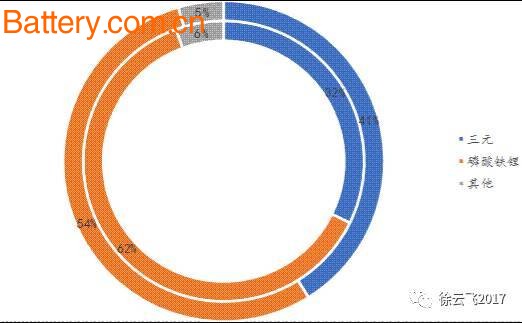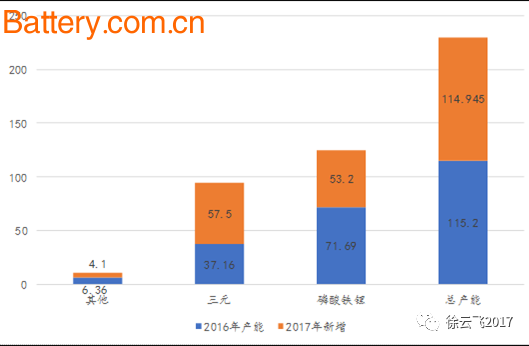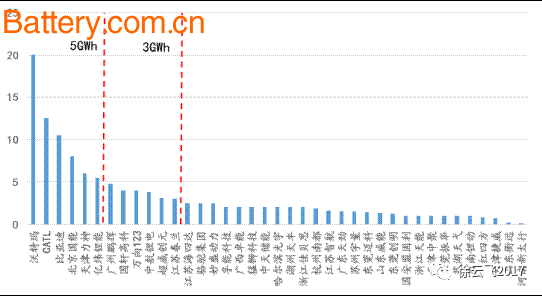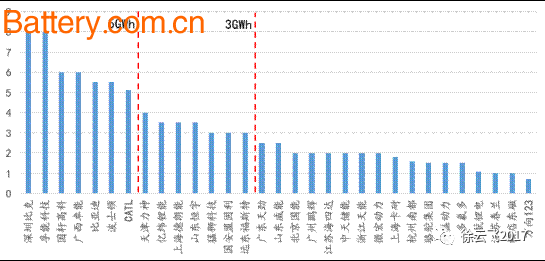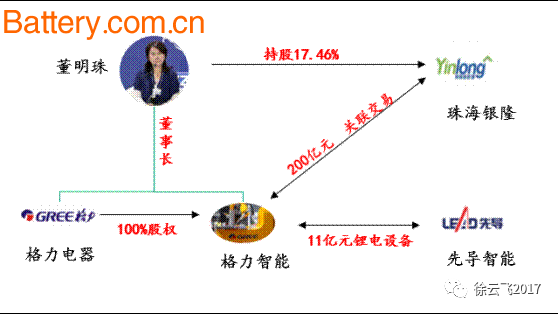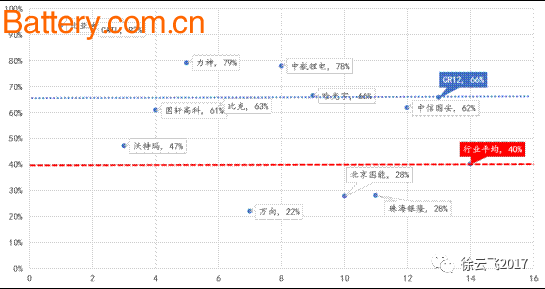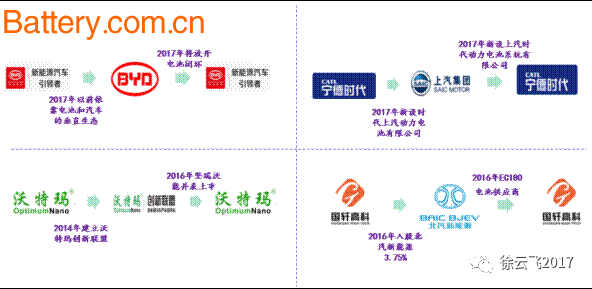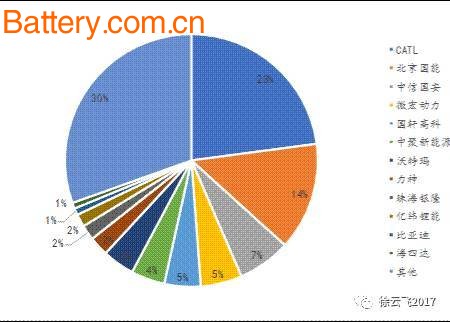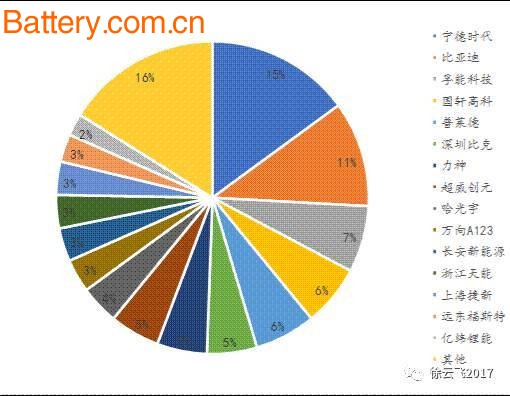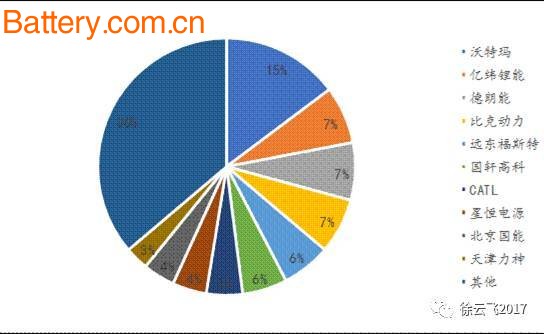In 2017, the capacity of lithium-ion power will be released centrally. It is estimated that the total planned production capacity will reach 230.1GWh by the end of the year, and the capacity of 101GWh will increase by 127.8% compared with last year. According to industry research, we estimate that the effective production capacity is around 60-70GWh, which is less than the planned value. From the perspective of expansion of production structure, the new capacity of ternary battery is 57.5GWh higher than that of LFP battery (adding 53.2GWh), and the proportion of ternary battery capacity is expected to rise to 41%, while LFP battery is down 8 percentage points year-on-year to 54%. The new capacity of other types of batteries is only about 4.1GWh, and the proportion after expansion is reduced to 5%. Expanding the customer model is key. Under the rapid expansion of production capacity, the industry's capacity utilization rate in 2017 is expected to fall from the average of 40% last year. The industry giants will accelerate the staking, and the planned shipments will be higher during the year. Expanding customers will become the key to effective production release. In 2016, the capacity utilization rate of leading enterprises was higher than the average value (BYD and CATL are both above 90%), and power battery companies have adopted strategies to expand customer binding, and the model is more diversified: 1) Participating in car companies, deep binding. 2) Alliance mode to jointly expand the market. 3) Joint venture to build a factory to achieve a win-win situation. Accelerate the seizure of the supply chain and the growth differentiation trend of power lithium batteries. 1) The LFP faucet of the passenger car is basically locked in sales. The battery type of this link is still dominated by LFP (accounting for 70%). Due to the high concentration of new energy passenger cars , CR8 was 67.6% last year. The matching stability between mainstream suppliers such as CATL and Guoxuan is high. The future will benefit from a stable supply chain system and a stable growth pattern. 2) Passenger cars: The ternary rookie is competing for the entire vehicle supply chain. The passenger vehicle field is the main battlefield for the replacement of ternary batteries, and the proportion of ternary batteries has continued to increase. Battery companies are more dispersed in this field. The high sales volume of high-quality passenger car models is the focus of the giants. Companies with high-quality, high-energy-density battery technology, such as Fu Neng, can help the company grow rapidly if it can intervene in supply. 3) Special vehicles: The supply chain and competition pattern have a high probability of future changes. The subsidy standard for special vehicles is subsidized according to the distribution ladder, and the energy density is lower. The related power lithium battery enterprises in the industry have greater market opportunities and development momentum. At the same time, the special vehicle market pattern and battery support are scattered. The first four batches of catalogue batteries are promoted. The CR4 index of the number of supporting enterprises is only 36%. In this field, the competition of ternary batteries is fierce, and the supply chain and the pattern have a high probability of future changes. 1. The total amount of rapid expansion, leading the competition 1.1. Capacity-intensive release, the end of the year planning value of 200GWh We have calculated the relevant production capacity of more than 50 domestic power battery companies. According to the current planning volume, the total capacity of power battery planning at the end of 2017 will reach 230.1GWh, which is the 101GWh capacity disclosed by the Chemical and Physical Association at the end of 2016. The growth rate is 127.8%. Although the power lithium battery expansion plan is relatively large, according to industry research, we estimate that the effective production capacity is around 60-70GWh, which is less than the planned value. The most important features of this round of power lithium battery industry: 1) The whole industry is expanding production, and the leader is even worse. The CR10 index of the power lithium battery industry will increase from 44% in 2016 to over 52% in 2017. The leading expansion will be higher than the industry average, leading to further increase in concentration. In 16 years, the scale is generally small. Only the three companies of Waterma (12GWh), BYD (10.7GWh) and CATL (9.5GWh) have a capacity of over 8GWh, accounting for 28% of the total capacity. In 2017, lithium battery capacity was released centrally, and it is expected that there will be more than 10 companies with a capacity of over 8GWh by the end of this year. From the perspective of capacity pattern, there is basically no major change in leading enterprises. Waterma (20.4GWh), CATL (18GWh) and BYD (16GWh) continue to rank among the top three. Guoxuan Hi-Tech, Boston, Beijing Guoneng, Tianjin Force God and Fueng Technology are close behind. 2) The capacity expansion of SMEs is passive. In terms of structural ratio, SMEs' enthusiasm for this round of capacity expansion is also relatively accelerated, but limited by capital and technical personnel reserve restrictions, relatively conservative in overall capacity planning, 13 of which have a capacity of more than 5GWh (the top 10 are super 8GWh), the production capacity accounted for 59%, the remaining enterprises accounted for 41% of the total capacity, the average production capacity was about 2.5GWh, and the gap with large enterprises opened. Figure 1: Capacity distribution of power battery companies at the end of 2017 (unit: GWh) 1.2. Structural differentiation: ternary expansion increased by more than LFP The newly added capacity is concentrated in the ternary lithium battery, accounting for 41%. At the end of 2017, the new capacity of lithium iron phosphate battery is expected to be 53.2GWh, and the capacity after expansion will reach 124.91GWh, accounting for 54% of the total capacity, down 8 percentage points from 16 years. The new capacity of ternary batteries is 57.5GWh, 94.69GWh after expansion, accounting for 9 percentage points to 41%; the other types of batteries have an additional capacity of 2.1GWh, about 10.5GWh after expansion, and the proportion dropped to 5%. . Figure 2: Increase in the proportion of ternary capacity structure in 2016-2017 Lithium iron phosphate battery: stable and steady growth In 2017, 39 of our 50 mainstream companies produced lithium iron phosphate batteries, an increase of 4 companies over the previous year, with a total production capacity of 132.91 GWh, an increase of 84%. Overall, the iron-lithium pattern has changed little, and the overall expansion has begun to decrease. Among them, only the Watermark LFP has a large expansion, and the newly added 8GWh has a capacity of 20GWh at the end of the year. It is the only company that focuses on LFP. Other lithium-ion giant companies have added ternary, and CATL's iron-lithium battery has a new capacity of 4.6. GWh and Tianjin Lishen added 4.6GWh, which is lower than the ternary expansion capacity. From the distribution point of view, there are 6 above 5GWh, an increase of 3 over the same period of last year, the proportion of production capacity is 50%, an increase of 8 percentage points. Figure 3: Capacity changes in 2016-2017 2016 production capacity is our research income ? Three-element battery: more up-and-coming talents, higher growth rate than LFP In our statistics, 31 of the 50 companies have ternary lithium batteries, with a total capacity of 88.69GWh, a year-on-year increase of 135%. Due to the short time of the three yuan rise, the ternary lithium battery rookie and the traditional LFP company are basically at the same starting line, the ternary market pattern has not yet formed, and the traditional iron-lithium pattern is quite different, and some of the lithium-ion newcomers such as Fu Neng Technology, which have mastered the technological process, etc. The company hopes to achieve breakthrough through rapid expansion. The largest expansion of new capacity is: Fueng Technology (6GWh), Shenzhen BAK (5.5GWh), BYD (4.5GWh) and Guoxuan Hi-Tech (4GWh). The company with the largest capacity is BGW and Feneng Technology up to 8GWh. Guoxuan Hi-Tech (6GWh) and Guangxi Zhuoneng (6GWh). The expansion of ternary lithium battery is relatively fast. CR7 has increased by 25% to 45% last year, and the production capacity is above 5GWh. There are 14 above 3GWh, compared with 11 companies in 16 years, the production capacity increased by 39%. To 69%, the remaining 18 companies have a ternary capacity of less than 3GWh, accounting for only 31% of production capacity. Figure 4: Capacity distribution of lithium iron phosphate battery companies in 2017 Figure 5: Capacity distribution of ternary battery companies in 2017 ? Other types of batteries: There are mainly lithium titanate and lithium manganate batteries. We have counted Zhuhai Yinlong and Weihong Power's two lithium titanate battery companies and lithium manganate battery company Suzhou Xingheng. In 2017, our production capacity was 4GWh, 4GWh and 2.5GWh respectively, accounting for 5% of 2017 production capacity. In addition, according to our research, Zhuhai Yinlong Company is actively strengthening the layout of lithium titanate batteries and complete vehicles: Zhuhai Yinlong is not only the industry rookie of lithium titanate power battery, but also the leader of new energy bus . In 2016, it sold more than 6,200 orders of pure electric buses. Its brand buses have been operated in more than 40 cities across the country. Fives. According to the announcement of the pilot intelligence on April 19, 2017, Gree Smart and Pioneer Intelligence signed an order for the production equipment of the latter stage of the lithium battery of 1.108 billion yuan (winding machine, die cutting, etc.), we assume that the purchase is mainly based on winder According to the calculation, the corresponding production capacity of the purchased batch of equipment is expected to be 6~8GWh, Gree Smart and Zhuhai Yinlong's 20 billion yuan related party transaction contract. It is expected that the expansion capacity of Yinlong Power Lithium Battery will be more than 8GWh in the future. A competitor that cannot be ignored in the power lithium battery industry. Figure 6: Gree Electric and Zhuhai Yinlong's new energy layout 2. Combine vertical and horizontal - expand customer model innovation 2.1. The capacity utilization rate declines and the expansion strategy tends to be diversified The decline in capacity utilization and the expansion strategy are key. According to the average production capacity and production statistics last year, the industry capacity utilization rate in 2016 was 40%, the capacity utilization rate of leading enterprises was higher than the average value, and the utilization rates of CATL and BYD were both above 90%. It is predicted that the demand for batteries in 2017 will be 37.5GWh (+34%). With the expansion of power lithium enterprises in the year (+125%), if the inventory is removed, it is expected that the capacity utilization rate in 2017 will drop somewhat, but leading enterprises such as CATL and BYD's shipment targets are relatively large, 14GWh and 12GWh respectively. Leading companies occupy the dominant position in the industry. Due to comprehensive consideration of industry competition, company profits and shipments, their expansion strategies will have an impact on the entire industry. Figure 7: Capacity utilization of leading companies is significantly higher than average (According to the average production capacity in 2015 and 2016) The stable supply chain system of new energy vehicles and power lithium batteries is in the interest of both parties. Power lithium battery companies are expanding their production capacity. Power battery manufacturers are actively expanding their car customers and enhancing user stickiness by improving product performance, adapting to demand trends, reducing costs and enhancing competitiveness, and customizing design and development to bind mainstream customers. Typical, such as Fueng Technology, through the vigorous development of ternary power lithium battery, its ternary soft pack battery energy density reached 220wh / kg, and actively integrated with Beiqi New Energy custom development, driving battery shipments. The cooperation strategy model between power battery companies and new energy vehicle companies is diversified: 1) Participation in car companies. Guoxuan Hi-Tech began to transform its ternary in 2016 and participated in the acquisition of EC180 and other models by participating in BAIC New Energy (accounting for 3.75% in 2016). 2) Alliance mode, group promotion. Waterma establishes an innovation alliance, through the complementarity of multi-link suppliers, promotes the overall strategy of the alliance, and brings performance growth to the industry chain companies within the alliance. In 2017, Watmar has received more than 10 billion passenger car orders, with the help of the alliance. The model establishes a moat. 3) Joint venture to build a factory with a win-win situation. In addition to broadly bound passenger car and commercial vehicle customers, CATL joined hands with Handicraft Group in May, newly established Power Battery Company and Battery PACK Company, respectively, which are Times SAO Power Battery Co., Ltd. (CATL 51%) and SAIC Power Battery System Co., Ltd. (CATL holds 49%). Deeply bound to SAIC through clear division of interests and division of labor. Figure 8: Power battery top four use alliance, shareholding, etc. to consolidate supply ecology Table 1: Binding of some battery companies and vehicle customers 3. Supply Chain Determinism - Power Lithium Growth Differentiation 3.1. Bus field: LFP faucet basically achieves sales lock The high power distribution of passenger cars is sensitive to the amount of subsidies. After the New Deal, the distribution energy density is generally close to the 115Wh/kg requirement of the highest-grade subsidy. In the first four batches of new energy promotion catalogue in 2017, the number of passenger vehicles with an energy density of 115Wh/kg or more has increased to about 40%. By adopting high-quality enterprise LFP battery products to meet high subsidy requirements, the bus battery type is still dominated by LFP, and the first four batches of catalog LFP batteries accounted for 70%. The passenger car is still the main driving force for LFP during the year. From the point of view of power distribution models, CATL has led the industry by 23%, and has achieved supporting cards for most mainstream car companies such as Yutong. Beijing Guoneng (14%), CITIC Guoan (7%), Weihong Power (5%) and Guoxuan Hi-Tech (5%) ranked second. According to the sales volume of last year, the CR8 index of China's new energy bus industry in 2016 is 67.6%. It is expected that under the pattern of stable increase of electric buses this year, the mainstream suppliers of related power lithium batteries such as CATL and Guoxuan will benefit from stable. The supply chain system and the growth pattern are also relatively stable. Table 2: 2017 1-4 batch passenger car catalog: density increase, LFP-based Figure 9: 2017 1-4 batch passenger car catalog battery matching proportion 3.2. Passenger car field: 30,000 yuan rookie competition for the entire vehicle supply chain is the key The passenger vehicle field is the main battlefield for the replacement of ternary batteries. The proportion of ternary batteries has continued to increase. The proportion of 120Wh/kg and above in the first four batches has increased to 21%. Judging from the matching situation of the first four batches of passenger vehicles, the downstream concentration of mainstream power lithium batteries is relatively low, and CATL (15%) ranks first, BYD (11%), Fueng Technology (7%), Guoxuan High Tech (5%) and Pride (5%) ranked second. CATL's main supporting vehicles include: SAIC, Geely, Chery, Beiqi and other mainstream passenger car companies. The sales of single models of electric passenger cars are much higher than those of passenger cars, especially the hot-selling models, such as the sales volume of the first four months of EC180. 11,481 vehicles, so from the perspective of supply relations, the supply chain of high-quality car models is the focus of ternary battery companies, such as the new energy supply chain of BAIC , the traditional suppliers are CATL, Guoxuan Hi-Tech, etc., Sanyuan rookie enterprise Fueng Technology It also realizes the partial support of EX260 and EC180 by virtue of its quality advantage, completes the matching of high-quality customers, and strengthens the certainty of future growth. Currently, the more mainstream supply chains are: Beiqi supply chain: CATL, Guoxuan Hi-Tech, Fueng Technology, Pride, etc. Geely supply chain: CATL, Guoxuan Hi-Tech, Tianfeng Power, Boston, Polyfluoro, Ha Guangyu, etc. Jianghuai supply chain: Guoxuan Hi-Tech, Tianjin Lishen, Huasheng Power, etc. SAIC supply chain: CATL, Wanxiang A123, CITIC Guoan, etc. Overall, the ternary power lithium battery market is expanding rapidly. The passenger vehicle supporting field currently accounts for a relatively low level, and the battery matching is relatively dispersed. The ternary battery enterprise can increase the performance of the product and increase the downstream market development. Therefore, the high-speed growth The market structure of ternary lithium battery remains to be seen. Table 3: 2017 1-4 batch passenger car catalog: energy density increase, ternary ratio is high Figure 10: 2017 1-4 batch passenger car catalog battery matching proportion 3.3. Specialized vehicle area: supporting competitive zone The subsidy standard for special vehicles is subsidized according to the distribution ladder, and the energy density is lower. The related power lithium battery enterprises in the industry have greater market competition opportunities and power. The first four batches of special vehicles are worthy of comparison. 15% occupied the top spot, and Yiwei Lithium Energy (7%), BAK Power (7%) and Delangen (7%) ranked second. Due to the short development cycle of special vehicles and stricter cost requirements, small and medium-sized battery companies actively develop logistics vehicles through price and quality competition, and the supply chain and competition pattern have a high probability of future changes. Figure 11: Proportion of battery packs for 1-4 batches of special-purpose vehicles in 2017 Blue Tungsten Oxide,Tungsten Oxide,Remelted Tungsten Trioxide,Sintered Tungsten Trioxide HUNAN ZHONGNAN ANTIMONY&TUNGSTEN TRADING CO.,LTD , https://www.znat.com.cn
